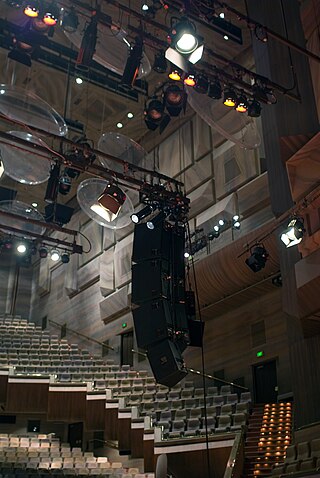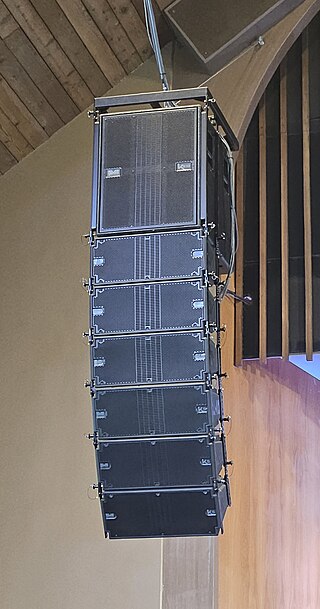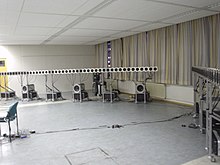
A loudspeaker is an electroacoustic transducer that converts an electrical audio signal into a corresponding sound. A speaker system, also often simply referred to as a speaker or loudspeaker, comprises one or more such speaker drivers, an enclosure, and electrical connections possibly including a crossover network. The speaker driver can be viewed as a linear motor attached to a diaphragm which couples that motor's movement to motion of air, that is, sound. An audio signal, typically from a microphone, recording, or radio broadcast, is amplified electronically to a power level capable of driving that motor in order to reproduce the sound corresponding to the original unamplified electronic signal. This is thus the opposite function to the microphone; indeed the dynamic speaker driver, by far the most common type, is a linear motor in the same basic configuration as the dynamic microphone which uses such a motor in reverse, as a generator.

A head-related transfer function (HRTF), also known as a head shadow, is a response that characterizes how an ear receives a sound from a point in space. As sound strikes the listener, the size and shape of the head, ears, ear canal, density of the head, size and shape of nasal and oral cavities, all transform the sound and affect how it is perceived, boosting some frequencies and attenuating others. Generally speaking, the HRTF boosts frequencies from 2–5 kHz with a primary resonance of +17 dB at 2,700 Hz. But the response curve is more complex than a single bump, affects a broad frequency spectrum, and varies significantly from person to person.

Ambisonics is a full-sphere surround sound format: in addition to the horizontal plane, it covers sound sources above and below the listener.

Surround sound is a technique for enriching the fidelity and depth of sound reproduction by using multiple audio channels from speakers that surround the listener. Its first application was in movie theaters. Prior to surround sound, theater sound systems commonly had three screen channels of sound that played from three loudspeakers located in front of the audience. Surround sound adds one or more channels from loudspeakers to the side or behind the listener that are able to create the sensation of sound coming from any horizontal direction around the listener.

Acoustical engineering is the branch of engineering dealing with sound and vibration. It includes the application of acoustics, the science of sound and vibration, in technology. Acoustical engineers are typically concerned with the design, analysis and control of sound.

Directional Sound refers to the notion of using various devices to create fields of sound which spread less than most (small) traditional loudspeakers. Several techniques are available to accomplish this, and each has its benefits and drawbacks. Ultimately, choosing a directional sound device depends greatly on the environment in which it is deployed as well as the content that will be reproduced. Keeping these factors in mind will yield the best results through any evaluation of directional sound technologies.
The precedence effect or law of the first wavefront is a binaural psychoacoustical effect concerning sound reflection and the perception of echoes. When two versions of the same sound are presented separated by a sufficiently short time delay, listeners perceive a single auditory event; its perceived spatial location is dominated by the location of the first-arriving sound. The lagging sound does also affect the perceived location; however, its effect is mostly suppressed by the first-arriving sound.

A horn loudspeaker is a loudspeaker or loudspeaker element which uses an acoustic horn to increase the overall efficiency of the driving element(s). A common form (right) consists of a compression driver which produces sound waves with a small metal diaphragm vibrated by an electromagnet, attached to a horn, a flaring duct to conduct the sound waves to the open air. Another type is a woofer driver mounted in a loudspeaker enclosure which is divided by internal partitions to form a zigzag flaring duct which functions as a horn; this type is called a folded horn speaker. The horn serves to improve the coupling efficiency between the speaker driver and the air. The horn can be thought of as an "acoustic transformer" that provides impedance matching between the relatively dense diaphragm material and the less-dense air. The result is greater acoustic output power from a given driver.
3D audio effects are a group of sound effects that manipulate the sound produced by stereo speakers, surround-sound speakers, speaker-arrays, or headphones. This frequently involves the virtual placement of sound sources anywhere in three-dimensional space, including behind, above or below the listener.
Virtual surround is an audio system that attempts to create the perception that there are many more sources of sound than are actually present. In order to achieve this, it is necessary to devise some means of tricking the human auditory system into thinking that a sound is coming from somewhere that it is not. Most recent examples of such systems are designed to simulate the true (physical) surround sound experience using one, two or three loudspeakers. Such systems are popular among consumers who want to enjoy the experience of surround sound without the large number of speakers that are traditionally required to do so.
Sound from ultrasound is the name given here to the generation of audible sound from modulated ultrasound without using an active receiver. This happens when the modulated ultrasound passes through a nonlinear medium which acts, intentionally or unintentionally, as a demodulator.
This page focusses on decoding of classic first-order Ambisonics. Other relevant information is available on the Ambisonic reproduction systems page.
Distributed Mode Loudspeaker (DML) is a flat panel loudspeaker technology, developed by NXT, in which sound is produced by inducing uniformly distributed vibration modes in the panel through a special electro-acoustic exciter. Distributed mode loudspeakers function differently from most others, which typically produce sound by inducing pistonic motion in the diaphragm.
A parabolic loudspeaker is a loudspeaker which seeks to focus its sound in coherent plane waves either by reflecting sound output from a speaker driver to a parabolic reflector aimed at the target audience, or by arraying drivers on a parabolic surface. The resulting beam of sound travels farther, with less dissipation in air, than horn loudspeakers, and can be more focused than line array loudspeakers allowing sound to be sent to isolated audience targets. The parabolic loudspeaker has been used for such diverse purposes as directing sound at faraway targets in performing arts centers and stadia, for industrial testing, for intimate listening at museum exhibits, and as a sonic weapon.
Psychoacoustics is the branch of psychophysics involving the scientific study of sound perception and audiology—how human auditory system perceives various sounds. More specifically, it is the branch of science studying the psychological responses associated with sound. Psychoacoustics is an interdisciplinary field of many areas, including psychology, acoustics, electronic engineering, physics, biology, physiology, and computer science.
The sweet spot is a term used by audiophiles and recording engineers to describe the focal point between two speakers, where an individual is fully capable of hearing the stereo audio mix the way it was intended to be heard by the mixer. The sweet spot is the location which creates an equilateral triangle together with the stereo loudspeakers, the stereo triangle. In the case of surround sound, this is the focal point between four or more speakers, i.e., the location at which all wave fronts arrive simultaneously. In international recommendations the sweet spot is referred to as reference listening point.
Amplitude panning is a technique in sound engineering where the same sound signal is applied to a number of loudspeakers in different directions equidistant from the listener. Then, a virtual source appears to a direction that is dependent on amplitudes of the loudspeakers. The direction may not coincide with any physical sound source. Most typically amplitude panning has been used with stereophonic loudspeaker setup. However, it is increasingly used to position virtual sources to arbitrary loudspeaker setups.
3D sound reconstruction is the application of reconstruction techniques to 3D sound localization technology. These methods of reconstructing three-dimensional sound are used to recreate sounds to match natural environments and provide spatial cues of the sound source. They also see applications in creating 3D visualizations on a sound field to include physical aspects of sound waves including direction, pressure, and intensity. This technology is used in entertainment to reproduce a live performance through computer speakers. The technology is also used in military applications to determine location of sound sources. Reconstructing sound fields is also applicable to medical imaging to measure points in ultrasound.
3D sound is most commonly defined as the daily human experience of sounds. The sounds arrive to the ears from every direction and varying distances, which contribute to the three-dimensional aural image humans hear. Scientists and engineers who work with 3D sound work to accurately synthesize the complexity of real-world sounds.
Apparent source width (ASW) is the audible impression of a spatially extended sound source. This psychoacoustic impression results from the sound radiation characteristics of the source and the properties of the acoustic space into which it is radiating. Wide source widths are desired by listeners of music because these are associated with the sound of acoustic music, opera, classical music, and historically informed performance. Research concerning ASW comes from the field of room acoustics, architectural acoustics and auralization, as well as musical acoustics, psychoacoustics and systematic musicology.










